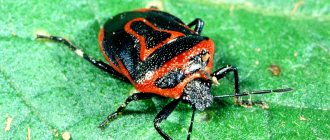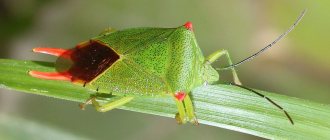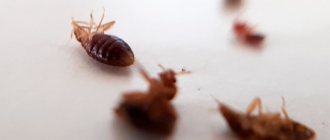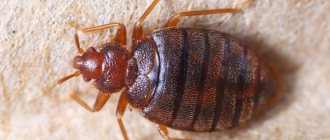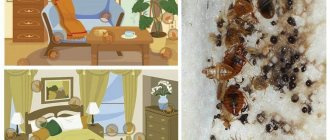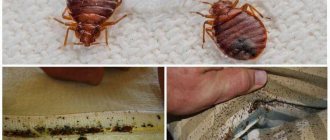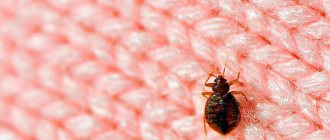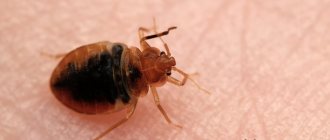Bed bugs are found in many houses and apartments throughout Russia. For a comfortable stay indoors, they need a more or less warm microclimate and a regular source of food, which is the blood of people and animals.
Of course, for humans and pets, living in the company of blood-sucking insects is not only unpleasant, but also dangerous to health. Very often, such proximity ends in multiple bites for people and animals, which lead to the development of serious allergic reactions.
How dangerous are bed bugs to human health?
With their presence in the house, ectoparasites cause great harm, which is expressed in the following:
- insects regularly attack humans, inflicting multiple bites. Traces from their attacks can itch for a long time and remain visible;
- due to ectoparasite bites, there is a high probability of contracting more than 40 dangerous diseases;
- Living in the same house with bed bugs is a constant stress that prevents you from sleeping and resting peacefully. As a result, a person’s well-being, mood and performance deteriorate;
- After an attack by pests, allergies often appear in the form of rashes, itching, burning and other reactions.
In addition, unsanitary conditions are created in the apartment and dirt appears. This is due to the fact that bedbugs constantly leave behind a characteristic brown discharge. It is extremely difficult to clean things, furniture and clothes from them, which creates additional stressful situations.
What do bed bugs look like?
The appearance of these pests depends on gender, stage of development and degree of saturation with blood fluid:
- Bedbug larvae reach 1.5-2 mm in length depending on age. They are distinguished from adult individuals by their coloring - the shade of their body is more transparent and lighter;
- a hungry adult ectoparasite reaches 1-3 mm in length. As the insect becomes saturated with blood, it can increase to 7 mm;
- males are easy to recognize by their more elongated body, females by their more rounded body;
- the color of the pest’s back can be red, copper or brown, depending on the level of saturation with blood fluid;
- a well-fed house bug turns purple due to the blood inside its translucent body;
- The insect has 6 legs and has mustaches on its round head.
When multiplying, pests lay eggs that are very similar to grains of rice. Their length does not exceed 1 mm. If you look at a photo of bedbugs, you will notice that their larvae immediately after hatching are full-fledged, but very small insects. Under favorable conditions, they grow to the size of an adult in 30-40 days.
How to distinguish from other insects in the house?
Due to the characteristic appearance of bedbugs, they can be easily identified against the background of other insects. From the outside they look like little bugs. They differ from cockroaches and ants by being slower and having a rounded, slightly pointed body shape.
They also cannot be confused with woodlice and centipedes, which have much larger legs. If it is still difficult for you to make the distinction, you need to take a high-resolution photo of the domestic bug on your phone, and then zoom in on the picture on the screen. This way you can see in detail all the details of the pest’s anatomy.
Bed bugs - lifestyle and activity
These insects prefer to live in dark, secluded corners where they can hide from people and animals.
In such favorable places, parasites can nest in whole colonies or alone. If you still managed to find their secret hideout, this does not mean that there is not another cluster of bedbugs in other parts of the apartment. It is important to consider that when they start in an apartment, they can disperse into different rooms. You can understand what a bedbug and its shelter look like from numerous photos on the Internet - they often show insects on the back of the mattress, the back of the bed and in other secluded places.
During the day, bedbugs are traditionally inactive. Their main activity begins at night from about 3 to 6 o'clock. During this period of time, bloodsuckers crawl out of their shelters to attack sleeping people. A person learns about their activity in the morning when he discovers bite marks on himself.
Therefore, the secluded rookeries of these insects are often located near places where people prefer to sleep or relax. This allows ectoparasites to quickly reach their victims and feed on blood. So it’s often not difficult to determine where bedbugs live in an apartment. As a rule, these are bedrooms or children's rooms.
What if your neighbors have bedbugs?
If your neighbors are poisoning bedbugs or it just turns out that they have parasites, then you need to protect your apartment with the help of a special insecticide. This type of pest control is called barrier protection or “putting up a barrier against bedbugs.” Not every product you can buy is suitable for installing a bedbug barrier. Long-acting microencapsulated or nanoencapsulated products should be used. To definitely protect yourself from unexpected pest invasions, use medications with a prolonged period of action. The substance should be active on treated surfaces for 4 to 6 months.
Reproduction of bed bugs
To effectively fight bloodsuckers, you need to know how they reproduce and develop.
This helps to easily detect insect nests and select appropriate methods to neutralize them. The following conditions in the apartment contribute to the rapid reproduction and maturation of larvae:
- temperature within 20-25 degrees Celsius;
- high humidity;
- a large number of dark places;
- constant availability of a food source (without human blood, bedbugs will not be able to reproduce).
If at least one favorable factor is missing, insects stop breeding and gradually die out. Their reproduction process occurs using the method of traumatic insemination. When mating, the male injects seminal fluid into the female’s abdomen, first damaging its walls. Then she can become fertilized herself and raise offspring. When the breeding season begins, the individual produces up to 5 eggs per day. They have a pronounced yellowish-dirty color, reaching a length of 1 mm, as can be seen from the photo of bedbugs in the apartment.
Over the entire life cycle, the female is capable of laying up to 500 eggs. After hatching, the larvae resemble smaller versions of the adults. Gradually, passing through 7 stages, they turn into fully formed insects 5.5 mm long, fully ready for reproduction. The ripening period is approximately 1-1.5 months. If there are unfavorable factors, the process may take up to 80-100 days.
Lifespan
On average, bedbugs live about 1-1.5 years.
The exact lifespan depends on the climatic conditions in which the insect lives and the availability of a regular food source (human/animal). If circumstances are favorable, without baiting with chemicals or physical neutralization, the pest calmly goes through all its life cycles, dying at the age of 1.5 years. Bedbugs are born singly in eggs. The larvae hatch after 2 weeks. Under favorable environmental conditions and constant availability of food, the larvae grow to the size of adults in 1-1.5 months. Therefore, you must always find and destroy parasite nests in a timely manner. It is important to remember that the larger they grow, the more dangerous bedbugs become for humans in an apartment.
If ectoparasites do not find a source of food, they slow down their metabolism for a while, hibernating. It is not uncommon for hungry individuals in search of warm-blooded animals to move en masse to other rooms using ventilation systems.
How are they transferred?
There are different ways to appear:
- The best food source for bedbugs is humans. Animals have natural protection - wool, thick skin. It is impossible to reach the bird. A person can bring insect eggs and adult individuals simply by visiting another room, going on a visit, visiting a cinema, hotel, metro or train;
- pets can bring a “gift”;
- Second hand is an excellent solution for buying budget clothing. But these are the things that can be infected with bedbugs or parasite eggs;
- when neighbors begin to poison insects, some of them leave the dangerous place, escape through cracks and doors. They can enter any apartment through the entrance to find a safe place;
- Where do bedbugs come from during renovations? They can migrate;
- Sometimes guests, housing office workers, and postmen bring parasites home. These people could have picked up insects in transport or in another apartment infested with bedbugs.
Where do bed bugs come from if there are no obvious reasons for it? Insects can live for a long time next to a person without revealing themselves. Sanitary treatment will not get them on the balcony, but with the onset of the warm season they will make themselves felt. An apartment that is not occupied by people for a long time becomes a place of pseudo-anabiosis (hibernation) for bedbugs. The appearance of human odor activates insects to attack.
Causes of bedbugs in the house
Pests can appear in residential areas if:
- lived in the apartment before you moved into it;
- sanitary and hygienic standards are not observed in the house where you live;
- were brought into the apartment by accident.
The first two situations are quite common. They can happen to anyone who, for example, purchased real estate on the secondary market, inherited it, or moved into rented housing. You often have to fight bed bugs in situations where unscrupulous neighbors live behind the wall. Bloodsucking creatures can crawl away from them in entire colonies, but only in cases of pathological unsanitary conditions.
If you suspect improper sanitary conditions in your attic or basement, you should have these areas inspected by your building management company. It is necessary to take several photographs on site. It is quite possible that stray animals or birds live there, which have become a factor for the appearance and reproduction of ectoparasites.
As for the accidental entry of bedbugs into an apartment, dozens of situations can set a precedent for this. The most common pests that enter the home are:
- with new things or furniture purchased in a store;
- with packaging materials;
- with pet hair after a street walk;
- with suitcases or bags upon returning from vacation;
- with any items that have been in locker rooms, on the seats of other people's cars or public transport.
note
Some varieties of bed pests are able to independently move from one room to another through ventilation shafts, cracks in the walls or through open windows.
We don’t end our search on the bed...
Now. You found bedbugs in the bed. This means that you need to look for them in the entire room, and preferably in the entire apartment. Here you need to inspect all the cracks, holes, cavities where they can physically get into. The following rule works here: the more difficult it is for you to get to a particular bedbug shelter, the more likely they are to have a nest there. Therefore, if you only plan to move the bedside table, look under it, lift a pot of flowers, look under it and that’s it, then you will almost certainly not find the main places where bedbugs accumulate.
In our practice, we were sometimes able to find bedbugs in completely unexpected places. I’m not talking about baseboards and under parquet floors - they are almost always there. But it happens that their nests are found behind books on shelves and behind the shelves themselves, inside laptops and computer system units, behind pictures on the walls, in safes, in sockets, in old things that people have not worn for a long time. You must understand that if you leave such places in your house, then there is a high probability that bedbugs will remain there, and even after treatment, individual individuals may survive here and restore the population in a few months.
Simply put, the bed is just the beginning. This is where you discover bedbugs and this is where you start looking for them. And where you will find all the other nests is very difficult to say. The main thing is to understand that bedbugs are not only infested in beds. It’s very, very rare that this happens: they are in the bed, but not anywhere else. But these are extremely rare cases, most likely this is not the case with you and they are somewhere else in the apartment. It just seems to you that they live in the bed simply because they only bite you when you are sleeping on the bed. But in reality they can be anywhere.
How can you tell if there are bedbugs at home?
It is almost impossible to immediately detect the appearance of “unwanted guests” due to their small size. In most cases, residents learn about the presence of ectoparasites later - by bites on the body.
At the same time, there are several other factors indicating that there are bedbugs in your apartment:
- characteristic brown dirt appeared on furniture and things;
- a bittersweet smell is detected in the room;
- behind the bed or under it you can find the ectoparasites themselves, as well as their larvae/eggs.
So, to determine the presence of pests in your home, you don't need to know everything about bed bugs. You just need to be a little observant.
How to avoid bringing bedbugs from an infested apartment?
If you often travel and go on business trips, living for several days in rented apartments or hotels, then when you move in, you should immediately bring your things into the bathroom. Blood-sucking parasites do not live there and will not be able to get into the suitcase. It is advisable to inspect the rest of the room for traces of bedbugs.
If they are found, treat everything with any insect repellent (Raid, Raptor, etc.).
In a dangerous apartment, it is advisable to leave bags with things locked. If you use your own bed linen, it is advisable to wash it at high temperature before leaving or pack it separately in a sealed bag so that it can be processed at home.
If you have doubts about the cleanliness of a room where you have to enter for a short time, you should refrain from sitting on upholstered furniture.
Where do bed bugs hide?
Pests traditionally choose dark, dry and well-sheltered areas as their habitat. They are often located near a food source (human/animal). Ectoparasites are most likely to be found in the following places:
- on the back of mattresses or upholstered furniture;
- under sleeping mats;
- in the shelves of bedside tables;
- under floor coverings (room bugs hide there if there are cavities);
- under window sills, baseboards and behind peeling wallpaper;
- in books and magazines;
- in clothes and shoes;
- in bed linen and pillows;
- on curtains and tulle;
- in cracks in the walls, ceilings and floors.
In all these places, insects hide during the day, digesting food and reproducing. Once you know where bed bugs live, you can easily neutralize them. It is only important to remember that there may be several such places in the apartment.
How to find a bedbug nest in a house?
Sometimes insects can hide in rooms not only singly, but also in entire colonies. To discover their rookeries, it is necessary to carefully examine all the rooms and the objects in them. This will be much easier and more effective if you adhere to the following recommendations:
- inspect the premises only during the daytime - this will allow you to examine each nook and corner in more detail;
- have a flashlight that will help you see places where light does not penetrate;
- move all furniture away from the walls - this is where bedbugs spread most often;
- if possible, disassemble the baseboards and remove the door jambs;
- expand the sleeping area;
- turn the mattress over and remove the covers from the pillows;
- examine duvet covers and pillowcases;
- unscrew the legs of the bed if they are hollow - from photos and pictures on the Internet you can understand that insects very often nest under them.
If a detailed examination does not yield any results, it is necessary to establish the cause of the bed bugs. Perhaps they come into the apartment through the ventilation shaft or from neighbors through cracks in the walls. Having figured out the cause, you will know exactly what to do and will be able to choose the most optimal measures to combat them.
Where do they settle?
Parasites find the most inaccessible, quiet areas of the room for nesting. They live quite comfortably in the dark and hard-to-reach places. The darker and quieter the corner, the greater the likelihood of insects being there. It is almost impossible to see pests during the day. All stages of the life of bloodsuckers take place exclusively at night.
During the day you can find insect locations. Nests are everywhere:
- a common place is under the mattress, closer to the victim of the attack;
- It’s also worth shaking up the furniture upholstery;
- Favorites may include crevices in skirting boards, places under wallpaper, behind the carpet;
- Sockets, switches, books, ventilation, clothes in closets, and household appliances should be inspected.
Bedbug bites
It is important to detect and neutralize ectoparasite nests in a timely manner in order to protect yourself from their regular attacks.
Bedbug bites can pose a serious danger, since many dangerous diseases are transmitted with them. In addition, very often they lead to allergic reactions such as swelling of the skin, itching and headache. Many people develop insomnia - a person simply cannot fall asleep, imagining bed bugs moving around his body. Recognizing that you have been bitten by pests is not difficult. The signs are classic: red dots on the human body, lined up in a pattern, small swellings and other characteristic symptoms.
Danger to humans
The greatest danger to humans is an allergic reaction. It occurs due to enzymes injected into the wound, and microparticles of chitin and excrement rising into the air with dust. Often an allergic reaction occurs even in people who are not prone to it.
Allergic reaction to a bedbug bite in a child.
Like all bloodsuckers, house bugs are capable of carrying serious diseases:
- typhus;
- tuberculosis;
- yellow fever;
- pseudotuberculosis;
- tularemia, etc.
Infection of an insect can occur from a previous owner, and, moving to a new one, the bug is capable of infecting it during its life.
If a private home is inhabited by rodents, with which bed parasites sometimes also come into contact, then the list of diseases will be even wider.
Methods for controlling bed bugs
There are 3 main ways to help get rid of blood-sucking insects in the house:
- Traditional methods. Aimed at destroying bed bugs of any size using kerosene, gasoline and other flammable and oily compounds. These liquids create an unpleasant odor for females and males. Despite all its effectiveness, this method cannot be considered safe, since a person himself can be poisoned by unary gases.
- Independent chemical methods. Aerosols, concentrates, sprays and, in some cases, powders are used. Before using this method, you need to find out where bed bugs are hiding, and then scatter the drugs or spray them in these habitats. The procedure must be performed in an apartment wearing special protective clothing. The use of insecticides allows you to quickly get rid of household bedbugs; it is only important to keep children and animals out of the room during treatment.
- Professional pest control. The most effective and safest of all methods. Effective in the fight against domestic bedbugs and their larvae. The premises are treated using hot and cold fog. This can only be carried out by special services that know everything about the life activity of bedbugs, their habitats and safety precautions when cleaning apartments from parasites.
Thus, using any of the listed methods, you will forever forget about the possible harm from bedbugs. You will no longer need to think about what color their secretions are, in what places they hide and at what time they go hunting. After treatment, it is only important to maintain proper sanitary and hygienic conditions in the premises.
Calculator
Ways to get rid of blood-sucking parasites
When it turns out that the apartment is infested with bedbugs, you should immediately begin the fight to destroy harmful insects while their number is small. Because in the early stages of infection they are easier to deal with. Residents themselves try to exterminate bedbugs with boric acid, vinegar, using special aerosols, and boil linen and clothes. Sometimes the simplest and most effective method is to get rid of the very cause of dominance, we are talking about a thing or object in which parasites appear. Throw away your mattress, bed or sofa. But if this option does not suit you, then it would be more advisable to call a team of disinfectors.
Using disinfectants that are not freely available, specialists will treat your entire apartment or house and destroy not only adult bedbugs, but eggs and larvae of bedbugs. When trying to poison parasites on your own, you need to take into account that individuals have already developed immunity to some agents, and they may not work on them, so the best solution would be to contact a special pest control service. After processing, such companies provide a guarantee.
